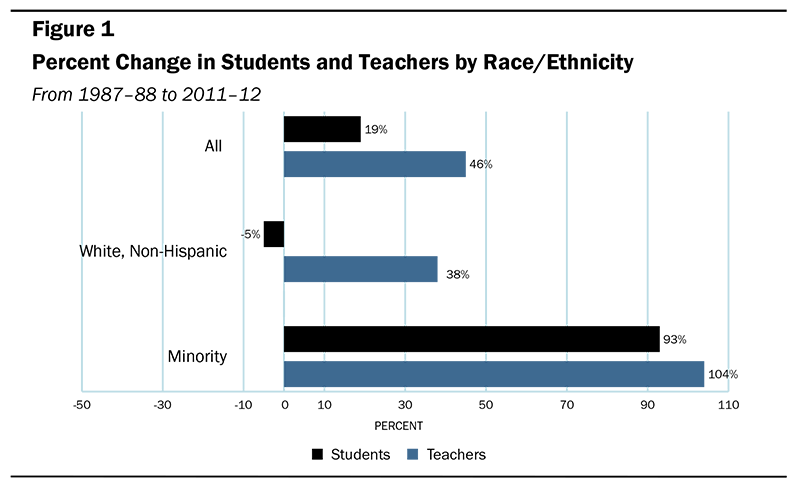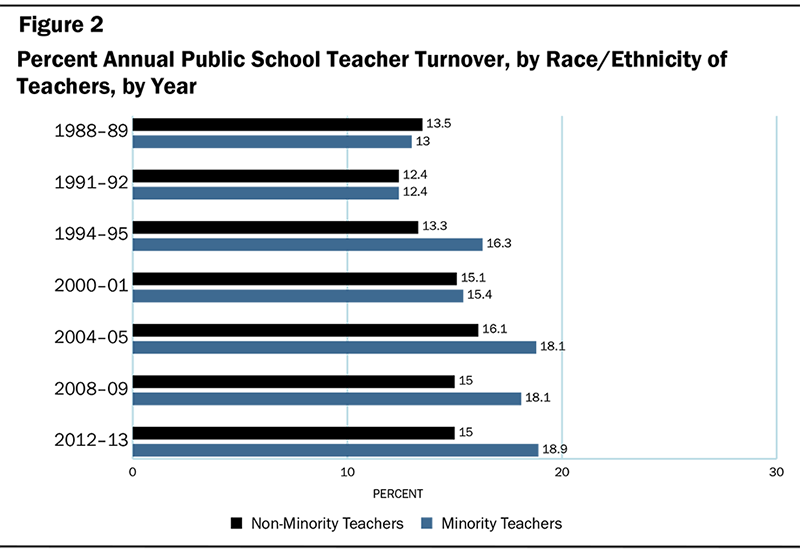Minority Teacher Recruitment, Employment, and Retention: 1987 to 2013

Summary
This brief summarizes the results from a study of the recruitment, employment, and retention of minority k-12 teachers. The study examines the extent and sources of the minority teacher shortage—the low proportion of minority teachers in comparison to the increasing numbers of minority students in the school system. Using the National Center for Education Statistics’ Schools and Staffing Survey/Teacher Follow-Up Survey, we found that efforts over recent decades to recruit more minority teachers and place them in disadvantaged schools have been very successful. But these efforts have been undermined by the high turnover rates of minority teachers—largely because of poor working conditions in their schools. The conditions most strongly related to minority teacher turnover were the degree of teachers' classroom autonomy and input into school decisions—both increasingly important when coupled with accountability pressures.
For the past several decades, shortages of minority teachers have been a big issue for the nation’s schools. There is widespread agreement that our elementary and secondary teaching force should “look like America.” But it is also widely lamented that as the nation’s population and students have grown more racially and ethnically diverse, the teaching force has done the opposite and grown less diverse. The result, in this view, is that minority students in the nation’s schools increasingly lack minority adult role models and contact with teachers who understand their racial and cultural background. The minority teacher shortage, it is held, is a major reason for the minority achievement gap and, ultimately, unequal occupational and life outcomes for disadvantaged students. In short, the minority teacher shortage is a major civil rights issue.
The main source of this shortage, conventional wisdom holds, lies in problems with the teacher supply pipeline. Too few minority students enter and complete college, and those who do have an increasing number of career and employment options aside from teaching. Moreover, when minority candidates do seek to enter teaching, this view holds that they encounter barriers—in particular, teaching entry tests, on which minority candidates have lower pass rates. The result is the minority-teacher shortage.
The main policy response to this problem, understandably enough, has been to try to recruit more minority candidates into teaching. In recent decades, numerous government and nongovernment organizations have tried a variety of minority-teacher recruitment programs and initiatives, including future-educator programs in high schools, partnerships between community colleges and four-year teacher education programs, career ladders for paraprofessionals in schools, and alternative teacher certification programs. Support for these efforts has been substantial. For instance, beginning in the late 1980s, the Ford Foundation, along with the DeWitt Wallace-Readers’ Digest Fund, committed more than $60 million to minority teacher recruitment and preparation programs. Many of these initiatives have been designed to bring minority teachers into schools serving predominantly minority student populations, often in low-income, urban school districts. Some of these initiatives have been designed specifically to recruit male minority teachers, who are often considered to be in the shortest supply. More than half the states have had some sort of minority teacher recruitment policy or program in place. Have these efforts been successful? Has the teaching force grown more diverse? And if not, why not?
Recently, we undertook to answer these questions. We analyzed two-and-a-half decades of data from 1987 to 2013 from the Schools and Staffing Survey (SASS) and its supplement, the Teacher Follow-Up Survey (TFS). This national survey, conducted by the U.S. Department of Education and the Census Bureau, is the largest and most comprehensive source of information on teachers in the nation. We did not focus on the contentious question of whether minority teachers are better at teaching minority students. Rather, our objective has been to use the best national data available to focus the debate on the extent and the sources of minority-teacher shortages.
We sought to address the four questions that follow:
- Has the number of minority teachers changed?
- Where are minority teachers employed?
- How high is minority teacher turnover?
- What are the sources of minority teacher turnover?
This research brief summarizes our major findings. Our detailed report will be forthcoming from the Learning Policy Institute. (See Ingersoll & May 2016.)Our larger LPI report and this research brief both draw from and update several earlier publications on minority teacher recruitment and retention. See, Ingersoll & May 2011a, Ingersoll & May 2011b, and Ingersoll 2015.
Recruitment and Employment
The data clearly show that there continues to be a persistent gap between the percentage of minority students and the percentage of minority teachers in the U.S. school system. For instance, in the 2011–12 school year (the most recent SASS data available), 37% of the nation’s population was minority, and 44% of all elementary and secondary students were minority, but only 17.3% of all elementary and secondary teachers were minority. But the data also show that this gap is not due to a failure to recruit minority teachers. Instead, the gap has persisted in recent years largely because the number of non-minority students has decreased, while the number of minority students has increased.
Since the late 1980s, the number of elementary and secondary teachers has dramatically increased. This is especially true for minority teachers, whose numbers more than doubled from about 325,000 to 666,000 by 2012. In fact, growth in the number of minority teachers outpaced growth in the number of minority students and was over twice the growth rate of non-minority teachers (see Figure 1). Even as the size of the teaching force has grown, the proportion of the teaching force that is minority has increased steadily—from 12% to over 17%. Moreover, the growth of teachers outpaced that of students for all but one of the major minority subgroups. For Hispanics, Blacks, and Asians, growth in teachers outpaced growth in students. The exception to this growth was Native American teachers, who declined in number by 30%. Native Americans comprise only 1% of students and less than half a percent of the teaching force. So, while there is still not parity between the proportions of minority students and minority teachers in schools, the teaching force has grown more diverse.
Moreover, minority teachers are overwhelmingly employed in public schools serving high-poverty, high-minority, and urban communities. Minority teachers are two to three times more likely than non-minority teachers to work in such hard-to-staff schools. Hence, the data show that in spite of competition from other occupations for minority college graduates—and in spite of apparent barriers to entry—efforts over recent decades to recruit more minority teachers and place them in schools serving disadvantaged and minority student populations appear to have been successful. This has been something of an unheralded victory. While commentators and researchers have at times tended to discuss the minority teacher shortage in pessimistic terms—often accompanied by calls for more funding and support—the data suggest that such efforts and expenditures have worked.

Retention
While minorities have entered teaching at higher rates than non-minorities over the past two-and-a-half decades, minority teachers also have left schools at higher rates. Overall, the data show that minority teachers’ careers have been less stable than those of non-minority teachers, and included more job transitioning (see Figure 2). In recent years, minority teachers were more likely to migrate from one school to another or to leave teaching altogether. This was especially true for male minority teachers.
Some turnover and departure of teachers from their jobs is normal, inevitable, and beneficial. For individuals, departures that lead to better jobs, in teaching or elsewhere, are a source of upward mobility. For schools, departures of low-performing employees can enhance school performance. For the educational system as a whole, some teacher career changes—such as moving from one school to another or leaving classroom teaching for other education-related jobs—do not represent a net loss of human capital to the educational system.
However, from the viewpoint of those managing particular schools and those seeking to employ more minority teachers in their schools, none of these types of departures are cost-free. All have the same effect: They reduce the number of minority teachers in the classroom. One consequence of such turnover, our analysis reveals, is that it undermines efforts to address the minority teacher shortage. This is starkly illustrated with data from 2004–05. The data show that at the beginning of the 2003–04 school year, about 47,600 minority teachers entered teaching; however, by the following year, 20% more—about 56,000—had left teaching. These data convey an image of a revolving door: too many going in one door and out another.

Why do minority teachers depart from their schools at higher rates? Strikingly, while the demographic characteristics of schools appear to be highly important to minority teachers’ initial employment decisions, these school characteristics do not appear to play a role in later decisions about whether to depart. Unlike for non-minority teachers, a school’s enrollment of poverty-level students, its minority-student enrollment, its proportion of minority teachers, or its location in an urban or suburban community were not strongly or consistently related to the likelihood that minority teachers would decide to stay or depart.
What does matter when minority teachers decide whether to stay or depart are school working conditions. The same hard-to-staff schools that are more likely to employ minority teachers are also more likely to have less desirable working conditions. And these less desirable conditions, our data suggest, account for the higher rates of minority-teacher turnover. In other words, the data indicate that minority teachers are employed at higher rates in schools serving disadvantaged students, but also depart at higher rates because these same schools tend to be less desirable as workplaces. The tragedy is that the success of minority teacher recruitment efforts have been undermined. Even more striking is what we found when we looked at which conditions were most correlated with minority teachers’ departures. Salary levels, the provision of useful professional development, and the availability of classroom resources all had little association with whether they were likely to depart. The strongest factors by far for minority teachers were the level of collective faculty decision-making influence in the school and the degree of individual instructional autonomy held by teachers in their classrooms. Having influence and autonomy in the workplace are, of course, key hallmarks of respected professions. Schools that provided more teacher classroom discretion and autonomy, as well as schools with higher levels of faculty input into school decision making, had significantly lower levels of minority teacher turnover.
What Can Be Done?
In supply-and-demand theory, any imbalance between labor demand and labor supply can be referred to as a shortage, in the sense that too few individuals are able and willing to offer their services under given wages and conditions. From this perspective, the problems many schools encounter in retaining minority teachers can technically be referred to as a shortage. However, in the context of minority teachers and schools, the term shortage is typically given a narrower connotation: an insufficient production and recruitment of new minority teaching candidates in the face of increasing minority student enrollments. These differences in terminology and diagnosis have crucial implications for prescription and policy.
Increasing teacher production and recruitment has long been the dominant strategy for diversifying the teaching force and addressing the minority teacher shortage. Nothing in our research suggests that bringing new, qualified minority candidates into teaching is not worthwhile. Indeed, our data suggest this approach has had remarkable success. In the two-and-a-half decades since the late 1980s, the minority teaching force has increased at over two-and-a-half times the rate of the non-minority teaching force.
But the data indicate that new teacher recruitment strategies alone do not directly address a major source of minority teacher staffing problems, namely, turnover. This is especially true for minority-teacher recruitment efforts aimed at male teachers, because male minority teachers have especially high turnover. Indeed, the ballooning of the minority teaching force is all the more remarkable because it has occurred in spite of the high turnover rate among minority teachers.
Of the more than 56,000 minority teachers who left teaching in 2004–05, about 16,000 retired, 30,000 left to pursue another job or career or because of job dissatisfaction, and 10,000 left for other reasons. Improving the retention of minority teachers recruited into teaching by addressing the factors that drive them out could prevent the loss of investment to recruit them in the first place and also lessen the need for more recruitment initiatives. All of this suggests that we should develop teacher recruitment and retention initiatives together. Recruitment alone has not solved either the problem of minority-teacher shortages or of filling positions in hard-to-staff schools. In plain terms, it makes no sense to put substantial effort into recruiting candidates to teach in schools serving disadvantaged students if those schools are not also desirable workplaces.
Our findings support the view that school organization, management, and leadership matter, and they shift attention to discovering which policy-amenable aspects of schools as organizations — their practices, policies, characteristics, and conditions—are related to a school’s ability to staff classrooms with minority teachers. The data suggest that poor, high-minority, urban schools with improved working conditions will be far more able to do so. To be sure, altering these conditions may not be easy. However, unlike reforms such as teacher-salary increases and class-size reduction, changing some conditions, such as teachers’ classroom autonomy and faculty’s schoolwide influence, should be less costly financially—an important consideration, especially in low-income settings and in periods of budgetary constraint.
External Reviewers
This report benefited from the insights and expertise of two external reviewers: Gloria Ladson-Billings, Kellner Family Chair in Urban Education at the University of Wisconsin-Madison; and Matthew Kraft, Assistant Professor of Education and Economics at Brown University. We thank them for the care and attention they gave the report. Any remaining shortcomings are our own.
References
Ingersoll, R. (2015). What Do the National Data Tell Us About Minority Teacher Shortages? In The State Of Teacher Diversity In American Education. (Section III, pp 13-22). Washington, DC: Albert Shanker Institute.
Ingersoll, R. & May, H. (2011a). Recruitment, retention, and the minority teacher shortage. CPRE Research Report #RR-69. Philadelphia, PA: Consortium for Policy Research in Education, University of Pennsylvania and Center for Educational Research in the Interest of Underserved Students, University of California, Santa Cruz.
Ingersoll, R. & May, H. (2011b). The Minority Teacher Shortage: Fact or Fable? Phi Delta Kappan, 93(1), 62-65.
Ingersoll, R. & May, H. (forthcoming in 2016). Minority Teacher Recruitment, Employment and Retention: 1987 to 2013. Learning Policy Institute, Stanford, CA.
Minority Teacher Recruitment, Employment, and Retention: 1987 to 2013 (research brief) by Richard M. Ingersoll and Henry May is licensed under a Creative Commons Attribution-NonCommercial 4.0 International License.
Research in this area of work is funded in part by the S. D. Bechtel, Jr. Foundation. Core operating support for the Learning Policy Institute is provided by the Ford Foundation, the William and Flora Hewlett Foundation, and the Sandler Foundation.
